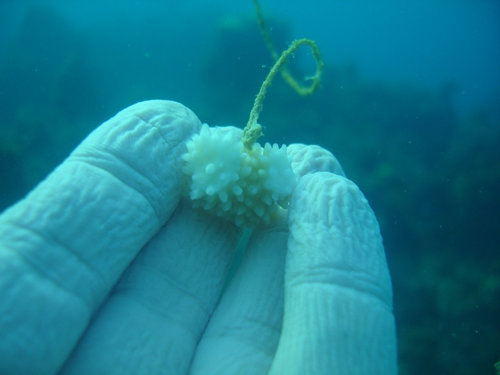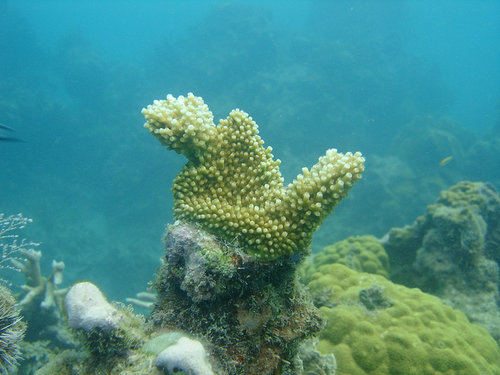Seascape Caribbean works at the forefront of the field in efficiency, predictability and durability of coral (ecosystem services) enhancement projects that they be applicable to the needs of the private and pubic sectors. Dr. Ross was a founding member to the Coral Restoration Consortium; a NOAA-facilitated global collaborative of coral restoration practitioners bringing the concept to the mainstream.
fresh THINKING, Novel TECHNIQUEs
As a private contractor working to discrete deliverables, predictability is a primary concern in implementation, grow-in and once established. This implies effective assessment of client goals and site as-is, as-adapted and as-intended, followed by efficient implementation and strong productivities in the growing-in system as per the contracted timeline. As such we take care to remain up-to-date on material, method and equipment developments; however, often we must be that innovator to address our (client) needs.
Our approaches fall into three broad themes, often employed in concert to achieve shore and long-term goals:
Maintenance or reef-gardening, wherein the reef is actively maintained for damaged or downed coral including planted coral, predators, algae and entanglement flotsam by a trained technician. This will often be combined with a fisheries management programme and snorkelling-related ROI.
Horticultural, wherein large corals are cultured and planted with expectation of rapid, high impact and strong survivorship. These programmes hold large corals in attractive, high-visibility nurseries for guest viewing and strong social media impact.
Silvicultural, wherein large numbers of much smaller corals are cultured through a minimal in-nursery period to be planted at numbers/scales for a slower and softer but ultimately greater impact in scope and scale, including for wave attenuation for coastal protection. These industrializing systems are somewhat less aesthetically interesting, but may be populated by divers or via land-based works that may be guest-visible.
techniques & TECHNIcal collaboration
We have made several inventions and hold several patents within these and tangential themes, all available to registered collaborator-colleagues. We also provide design consultancy, collaboration and seed-support in adaptation to current, pending and novel inventions in this and related fields. Please contact us for your pass-code.
RESEARCH HIGHLIGHTS
Early assays culturing elkhorn coral (Acropora palmata) nubbins in a Drop-Loop Line Nursery (BDL) at the Doctor’s Cave Bathing Beach Club in Montego Bay, Jamaica, circa 2006. Several fo these corals are still alive on the reef, to be reemployed in the current “reboot” of this work at Doctor’s Cave.
A staghorn coral (Acropora cervicornis) nubbin recently set to culture and illustrating healing and new polyp formation at the Goldeney Resort and Oracabessa Bay Fish Sanctuary in St. Mary, Jamaica, in 2009.
Growing staghorn coral (Acropora cervicornis) in a buoyant drop-attachment line nursery at the Goldeney Resort in Oracabessa Bay, St Mary, Jamaica.
Freshly-set two-hundred isolate buoyant drop-line attachment nursery systems of staghorn coral (Acropora cervicornis) at the Goldeney Resort and Oracabessa Bay Fish Sanctuary, St Mary, Jamaica, circa 2010.
An elkhorn coral (Acropora palmata) grown from a fingernail-sized nubbin and set to adjacent reef eighteen-months previous at the Goldeneye Resort and Oracabessa Bay Fish Sanctuary, St Mary, Jamaica.
Ceramic Ecoreef artificial reef modules assembled and prepared for deployment in Falmouth, Jamaica, circa 2011. No corals were set to these modules.
Ceramic Ecoreef modules loaded for deployment to the Bluefields Bay Fish Sanctuary in Westmoreland, Jamaica, by Halreefs Inc., circa 2012.
Buoyant drop-line attachment line of staghorn coral (Acropora cervicornis) nubbins (N=1000) in head-start for setting to the Ecoreef modules visible beneath. This work was at Discovery Bay, St Anns, Jamaica circa 2012, in collaboration with the Discovery Bay Marine Laboratory and University of the West Indies, as remediation for dredging of the Discovery Bay port.
All three Caribbean species of the branching coral genus Acropora in a single buoyant drop-loop line nursery at the Doctor’s Cave Beach Club in Montego Bay, Jamaica, circa 2007.
Elkhorn coral ( Acropora Palmata) in a buoyant drop-attachment line nursery, ready to be planted to the reefscape at the Doctor’s Cave Beach Club in Montego Bay, Jamaica, circa 2008. These corals illustrate the vibrant gold of this species in shallow water.
A bin of nursery-grown staghorn corals (Acropora cervicornis) ready to be planted into the Oracabessa Bay Fish Sanctuary by the “Coral Gardeners” of the Oracabessa Marine Trust.
Mature staghorn corals (Acropora cervicornis) bagged and ready for transport to the planting site in the Oracabessa Bay Fish Sanctuary by the fishers of the Oracabessa Marine Trust.
Dr Ross cleaning hydroids from one of the first line nursery trials in Montego Bay, Jamaica, in 2005. Both staghorn (A. cervicornis) and fused-staghorn (A. prolifera) were in this nursery, thought the research focussed on the staghorn lineages.
An odd location-specific morphology of Agaricia agaricites at the Pedro Keys off the south coast of Jamaica as part of the Science Without Borders expedition of 2012. The spacial plasticity of this and other coral species is part of why we preferentially use source/parent corals of within 1000m of the intended planting and nursery sites.
Old-style bamboo Antillean-Z fish pots in Bluefields Bay, Westmoreland, Jamaica- one of the the last places one can find these beautiful devices.
Buoyant drop-line line nurseries of newly-set staghorn coral nubbins (Acropora cervicornis) in Negril, Jamaica.
Cultured corals on an array of buoyant drop-line line nurseries in the Oracabessa Bay Fish Sanctuary, St Mary, Jamaica.
Planting cultured corals along a transect through an urchin-grazed bit of reef in the Oracabessa Bay Fish Sanctuary with the fishers of the Oracabessa Marine Trust. This was the first primary out-plant of this ongoing programme, growing and setting nearly 4000 corals as fish and shellfish nursery habitat.
Growing fused staghorn (Acropora prolifera) corals in buoyant drop-line line nursery culture in Oracabessa Bay, St. Mary, Jamaica, right in front of the Goldeney Resort and a little down-coast from Ian Fleming’s writing cabin- the birth place of James Bond.
Newly healed and starting growing, a nubbin of elkhorn coral (Acropora palmata) nursery-grown in the Oracabessa Bay, St Mary, Jamaica.
Fused staghorn corals (Acropora prolifera) nearly ready for planting in the Oracabessa Bay Fish Sanctuary with and by the fishers of the Oracabessa Marine Trust.
Fisher-Gardeners of the Oracabessa Marine Trust harvesting staghorn (Acropora cervicornis) and fused-staghorn (A. prolifera) golden branching corals from the buoyant drop-line line nurseries of the Oracabessa Bay Fish Sanctuary, St Mary, Jamaica, right in front of the Goldeney Resort.
Fisher-gardeners of the Oracabessa Marine Trust line-tie planting staghorn corals (Acropora cervicornis) to an urchin-grazed reef of the Oracabessa Bay Fish Sanctuary, St Mary, Jamaica. This project is intended to bolster fish/shellfish productivity within the bay, thus focusses on nursery-ticket forming branching coral morphologies and species of the genus Acropora.
Dr Ross providing line-tie planting method training to the fisher-gardeners of the Oracabessa Marine Trust a little bit north of Ian Fleming’s writing cabin at the Goldeney Resort in St Mary, Jamaica.
Fisher-gardeners of the Oracabessa Marine Trust making final preparations to the fused-staghorn corals (Acropora prolifera) of the nursery prior to planting to the reefs of the Oracabessa Bay Fish Sanctuary.
Elkhorn corals (Acropora palmata) ready for planing from the buoyant drop-line attachment line nursery at the Goldeney Resort in the Oracabessa Bay Fish Sanctuary, St Mary, Jamaica. The ‘scoop’ shape is the coral trying to grow sideways, but sinking or swinging with its own weight.
A mature buoyant drop-loop line nursery of staghorn corals (Acropora cervicornis) at the Doctor’s Cave Beach Club in Montego Bay, Jamaica, circa 2008.































